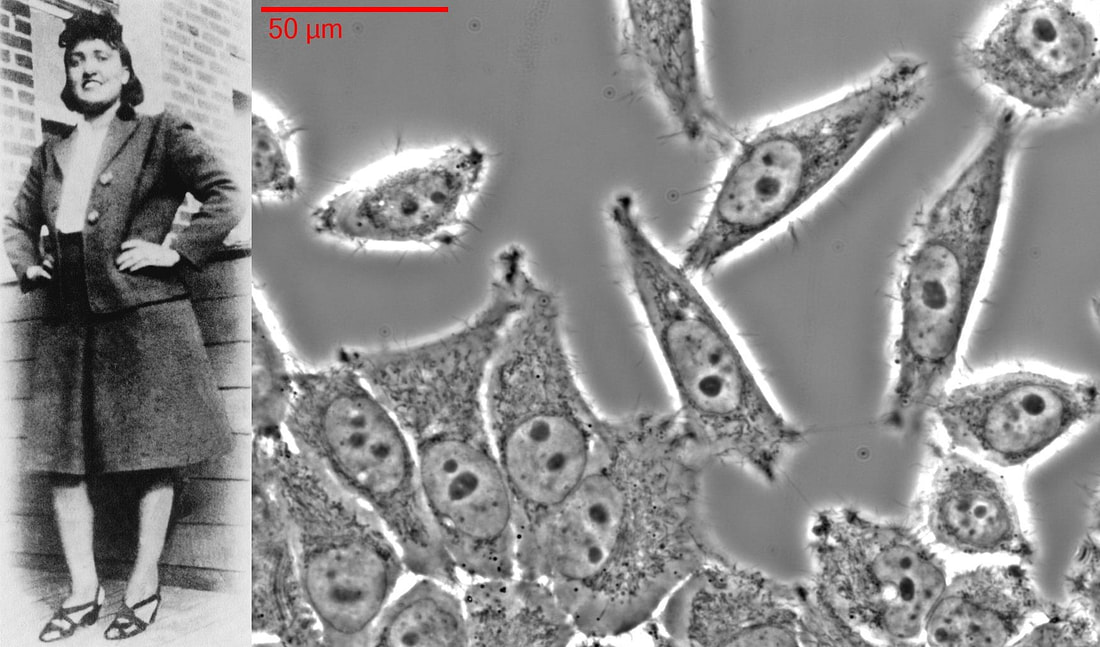|
The development of the capacity to culture cells ushered in a revolution in the biological sciences because it allowed scientists to remove cells from the great complexity of the live organism and grow them in a controlled environment where they could study the chemical and physical changes that the cells exhibited during their life cycle in response to both normal and pathological stimuli. The nature and role of many molecules and fundamental processes going on in living things have been discovered thanks to cell culture research, and this has in turn allowed the development therapies for many diseases. Additionally, cells have also been used as tools to screen for new drugs, grow pathogens, test the effects of changes in genes, and in the future may allow the creation of replacement organs. During my scientific career, I have worked with many cells including human cells. Most of the human cells I have worked with were cancerous cell lines derived from tissues such as breast, pancreas, ovary, colon, and cervix. The way these cell lines are generated is that they are initially isolated from a cancer found in an organ, and they are then grown in culture flasks for several generations. Once enough cells are available, they are frozen and stored under conditions that do not harm them, and they can be packed in dry ice and shipped to laboratories around the world. Nowadays you can buy these cells from companies that have divisions that are specialized in cell culture. When I do an experiment with human cells, I am primarily focused on getting the science and the procedure right. However, when I peer through my microscope at those tiny things that swarm and multiply in my culture flasks, I sometimes wonder about the human beings from whom they were taken. Who were these individuals? What did they do? Where did they come from? What challenges did they face in life? What were their opinions about local and world events and trends? What foods and music did they like? What books did they read? Were they killed by their cancers? How would they feel if they knew that I am looking at cells from their breasts or their prostates? When you purchase a cancer cell line, there is very little information available regarding the person from whose cancer the cells were generated. Normally only the age, sex, and ethnicity of the person are provided. Consider the most famous of all cell lines: the HeLa cell line. This was the first cell to be cultured, and it played a crucial role in the process that led to the development of the polio vaccine. The HeLa cells were isolated from a cervical cancer which killed a black woman named Henrietta Lacks in 1951. Since then, these cells have been extensively used for research all over the world and the story of Henrietta Lacks and her cells has been told in a remarkable book by Rebecca Skloot entitled, The Immortal Life of Henrietta Lacks. But if you purchase a vial of HeLa cells today, the only information presented regarding the person from which they were obtained is: Age: 31 years adult Gender: Female Ethnicity: Black There is extensive documentation regarding the genetic, biochemical, and physiological characteristics of the cells, as well as information regarding how to grow them and references to their use in research, but there is no information about Henrietta and her life. And some scientists would argue that, in addition to privacy issues regarding the individuals and their families, this is OK because cells are a tool, and any personal information regarding the individuals from which they originated is irrelevant.
Although I understand this argument, I still would like to know a little more about those individuals whose cells I am culturing and how they feel about it. I believe that if someone is donating their cancers to research, they should be given the option to at least write a few lines to the scientists that will be using their cells. For example: Dear Researcher, My name is Jane Doe. My doctors tell me that the cancer they will remove from my ovaries will be used to produce cell lines for research. I am praying that the surgery and the chemo will work, and that I will be able to spend more time with my daughter and my grandchildren. However, I want you to know that regardless of the outcome, I want you to make good use of my cells and find ways to treat this and other diseases. We all appreciate more time in this world, and I hope that God guides your studies and blesses you with clarity. When you peer through your microscope and look at my cells, I may be long gone, but remember that you will be handling a part of me that will outlive me and which represents a little of what I once was. So please take care of my cells and good luck in your research! or Dear Scientist, My name is John Doe. I have lived through a lot. I have been in wars. I have been shot. I have stared death in the face many times and survived. So it’s a bit ironic that this colon cancer may be the thing that brings me down, but we all sooner or later have to accept our fate. The doctors say they will use the cancer they take out from me to produce cells for research. It feels a bit strange to know that there will be a bunch of strangers handling cells from my colon, but if this helps to treat this disease, I am all for it. I love my country, and I value the time I spend with my family, and with my fellow vets when we get together to have some beers every now and then. I would appreciate any extra time I can spend with them, but if I can’t do it anymore, I hope your research will allow others that chance. So please make good use of my colon cells and have a beer for me next time you go to a bar with your research buddies. Godspeed. Including notes such as these in the information available in human cells used for research would give a little more humanity to the process as well as perspective and motivation for those of us using these cells. HeLa cell photograph from Fraunhofer-Institut für Biomedizinische Technik, St. Ingbert, Paul Anastasiadis, Eike Weiß is used here under an Attribution-ShareAlike 3.0 Unported (CC BY-SA 3.0) license. The photo of Henrietta Lacks from the Oregon State University Flickr webpage is used here under an Attribution-ShareAlike 2.0 Generic (CC BY-SA 2.0) license.
0 Comments
 Cisplatin Cisplatin A long time ago an old professor of mine told me a story. He visited a laboratory which recently had started a line of research involving the study of the pancreas. The lab had been doing this for one year and had generated data that was included in a couple of articles they had published. This was one of those labs where the principal investigator was always travelling, teaching classes, or writing grants, so he delegated a lot of the supervisory work to staff scientists. Unfortunately, one of the staff scientists turned out to have lax standards and did not supervise the graduate students and technicians under him a lot. My professor was touring the lab, and he walked by a technician and a student busy at work who told him they were dissecting a mouse’s pancreas for later analysis. However, when he looked closely, my professor was a bit confused. “What is it again that you are doing?” he asked. “We are removing the pancreas from this mouse”, the technician replied. My professor took a deep breath and awkwardly proceeded to inform them that the organ they had just removed was the spleen, not the pancreas. The lab had been working on the wrong organ! Many scientists tend to focus their attention on getting the big things right, but it is often the overlooked little things that can derail a project. An under researched or not very well thought out approach to an experiment, a lack of focus on the procedures, an improperly calibrated piece of equipment, a sloppy experimental methodology, or a not well-supervised lab hand is all it takes to introduce error into the science. And the problem is that the effort to prevent these mistakes from happening is often boring, repetitive, detail-intensive, unglamorous work that some scientists would rather have others do while they instead devote their time to reading, and discussing and thinking exciting and important ideas. Most mistakes, like the one I described at the beginning of this post, involve a few labs and they typically remain within the realm of the anecdote. However, other mistakes involve a large enough number of labs that they merit publication in the scientific literature. For example, in the cancer research field there is a drug called cisplatin that contains the element platinum and is used in the treatment of many cancers. Cisplatin and several similar compounds are also extensively researched in the lab. One of the issues with cisplatin and related compounds is their poor solubility in water. Because of this, many labs have employed other solvents to be able to make larger amounts of the drug go into solution. Among these solvents is one called dimethylsulfoxide (DMSO), which is often used to solubilize many hard to solubilize substances. The problem with using DMSO to solubilize cisplatin, as was pointed out in an article published in 2014, is that DMSO reacts with the platinum in the drug and inactivates it! The authors of the article found that anywhere from 11% to 34% of published studies in selected cancer journals used DMSO to solubilize cisplatin compromising the interpretation of the results. And the number was really bound to be higher as 26-50% of the studies did not report the solvent employed to solubilize cisplatin. The effect of DMSO on cisplatin had already been reported in the scientific literature 20 years earlier, but it seems that none of these labs were aware of the problem.  Henrietta Lacks Henrietta Lacks The above mistake and others like it are mostly occurrences that are not publicized beyond the complex technical field in which they originated. However, some mistakes involve so many labs, and are of such catastrophic proportions, that they actually find their way beyond the scientific literature and into the popular realm. Such was the case of the HeLa cell contamination. The first cell ever to be cultured was the famous HeLa cell. This cervical cancer cell line is named after the woman from whom the cells were isolated, Henrietta Lacks, who died in 1951. As the first immortal cell line, HeLa cells were sent all over the world and used for many experiments in various fields. Among notable achievements using HeLa cells was the creation of the polio vaccine. Other cell lines were also eventually obtained giving scientists even more tools to study various facets of both pathological and normal cell functions of different organs. The story of Henrietta Lacks and her cells is told in the book The Immortal Life of Henrietta Lacks by Rebecca Skloot.  HeLa Cells HeLa Cells However, as more and more cell culture work was performed, a few scientists including the notable researcher Dr. Walter Nelson-Rees discovered that the cell lines that many researchers were working with were not what they thought they were. The HeLa cells had taken over them! It seems that sloppy cell culture practices, such as working with several cells at the same time to speed up the pace of lab work, had led to contamination. As a result of this mistake, hundreds of published articles became worthless, tens of millions of research dollars were wasted, and several academic careers were derailed. Even though the techniques to authenticate cell lines and cell culture methods have improved significantly, contamination of cell lines by other cells (not just HeLa) still remains a significant problem today. The saga of the HeLa cell contamination is described in the book, A Conspiracy of Cells by Michael Gold. When the general public reads about scientific discoveries, they read about the end product of science. What is not conveyed is the long hours spent making sure the equipment, the procedures, and the people work the way they should. Remember, in science the devil is in the technical details! The photo of Henrietta Lacks from the Oregon State University Flickr webpage is used here under a Attribution-ShareAlike 2.0 Generic (CC BY-SA 2.0) license. The image of HeLa cells by Josef Reischig used under an Attribution-ShareAlike 3.0 Unported (CC BY-SA 3.0) license. The drawing of the formula for cisplatin has been placed in the public domain by Benjah-bmm27. |
Details
Categories
All
Archives
June 2024
|

 RSS Feed
RSS Feed